
Exploring Wi-Fi 7 What New Features Does Wi-Fi 7 Support
320MHz bandwidth
Wi-Fi 7 operates on three frequency bands: 2.4GHz, 5GHz, and 6GHz, and increases the maximum bandwidth to 320MHz to meet the stringent speed and latency requirements of emerging applications such as VR/AR, online games, and video conferencing. It also supports multiple bandwidth bonding modes, including continuous and non-continuous 240MHz, 160MHz+80MHz, 320MHz, and 160MHz+160MHz.
Wi-Fi 7 can provide greater bandwidth under the same number of streams and coding conditions, thereby achieving higher data transmission rates. This enables Wi-Fi 7 to meet the growing demand for high-bandwidth applications and provide a better user experience.
Figure 1: 320MHz bandwidth

4096-QAM modulation
QAM is a common digital signal modulation method in Wi-Fi. Wi-Fi 6 uses a modulation method up to 1024-QAM, with each symbol carrying 10 bits of information. As hardware modulation and demodulation capabilities continue to improve, Wi-Fi 7 will use a modulation method up to 4096-QAM, with each symbol carrying 12 bits of information. Therefore, compared with Wi-Fi 6, the information-carrying capacity of each symbol of Wi-Fi 7 will increase by 20%.
Figure 2: 1024-QAM vs 4096-QAM modulation
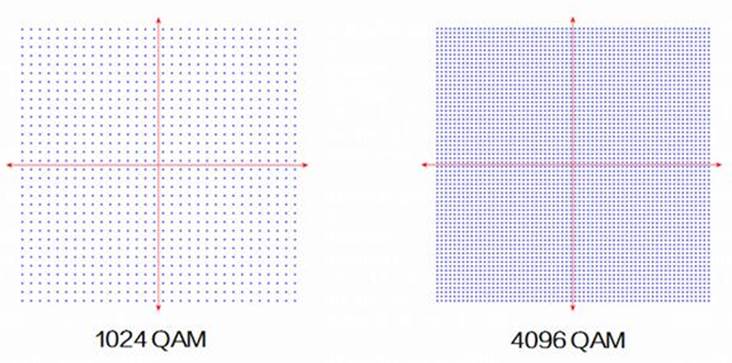
MIMO 16×16
MIMO (Multiple Input, Multiple Output) is a wireless communication technology that utilizes multiple antennas to transmit and receive signals, enhancing system capacity, coverage, and signal-to-noise ratio. Specifically, in MIMO configurations denoted as M×N, there are M antennas at the transmitting end and N antennas at the receiving end.
MU-MIMO (Multi-User MIMO) allows a single access point (AP) to communicate with multiple devices simultaneously, optimizing the use of spatial resources and increasing wireless data throughput. This technology is crucial for multi-user communication in wireless networks.
Wi-Fi 6 supports MIMO configurations of up to 8×8, while Wi-Fi 7 elevates this capability, supporting MIMO configurations of up to 16×16. The enhancement in MIMO capabilities means that the theoretical transmission rate of Wi-Fi 7 will be double that of Wi-Fi 6, allowing more devices to connect simultaneously.
Figure 3: 8×8 vs 16×16 MU-MIMO
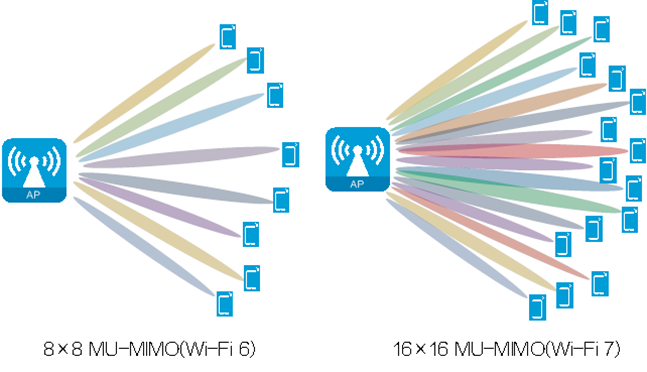
Multi-link operation
Wi-Fi 6 and previous standard wireless terminals also support multiple frequency bands, they can only establish one radio link with the AP at a time. The Wi-Fi 7 working group newly defines MLD (Multi-link Device), which can establish multiple radio links with the AP at the same time.
Wi-Fi 7 devices can switch and coordinate different links according to usage scenarios and air interface status to ensure more efficient, faster, and more reliable data transmission.
Figure 4: Multi-link device

Multilink can be simply divided into synchronous mode and asynchronous mode:
- Synchronous mode: Multiple RF links send and receive signals simultaneously, which can avoid interference caused by two links receiving and sending at the same time.
- Asynchronous mode: Multiple RF links perform channel detection, monitoring, and data transmission and reception independently. This mode does not have strict timing requirements, is simple to implement, and has a high degree of freedom. It is suitable for situations where the isolation between multiple links is sufficient and there is no mutual interference between RF links.
Figure 5: Multi-link device synchronous/asynchronous mode (Ref.802.11be draft1.3, Fig35-14)
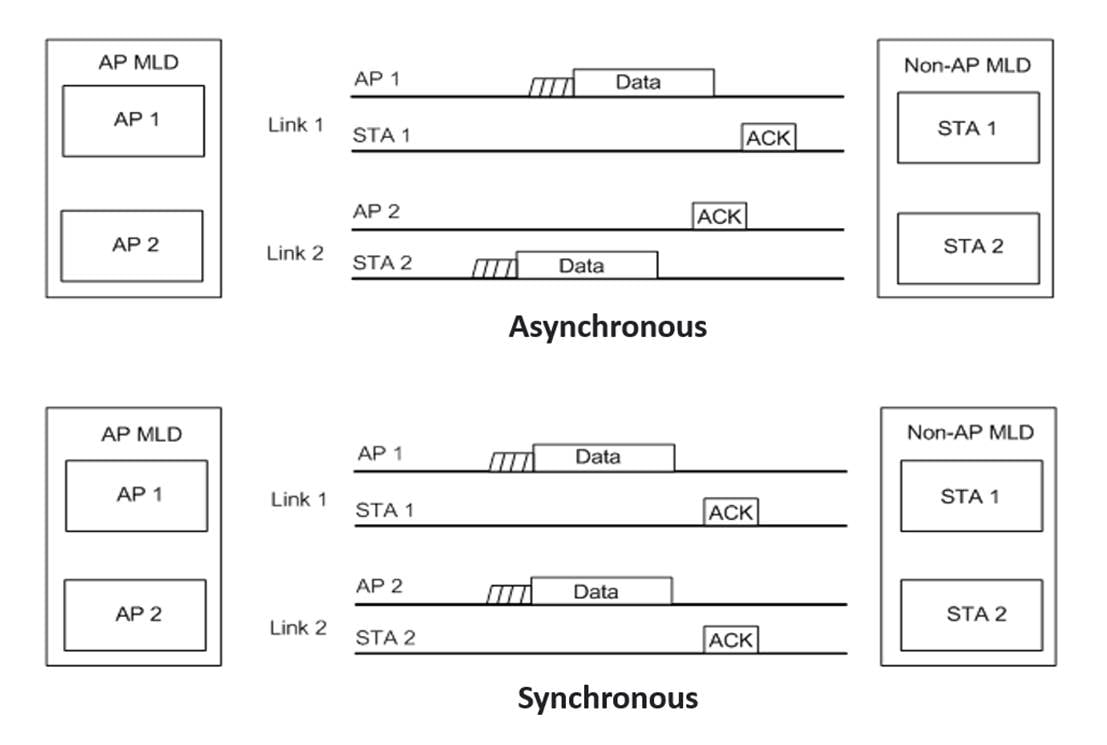
Typical modes of data transmission on multi-link devices are replication transmission and joint transmission:
- Replicate transmission: When multiple links transmit the same information and there is interference in one of the channel environments, the receiving end can effectively reduce the transmission delay based on the first-come, first-served principle. This method can also improve the reliability and quality of transmission.
- Joint transmission: Reasonably splitting a message and transmitting it on multiple RF links at the same time can effectively improve the transmission efficiency.
Figure 6: Multi-link device replication transmission and joint transmission
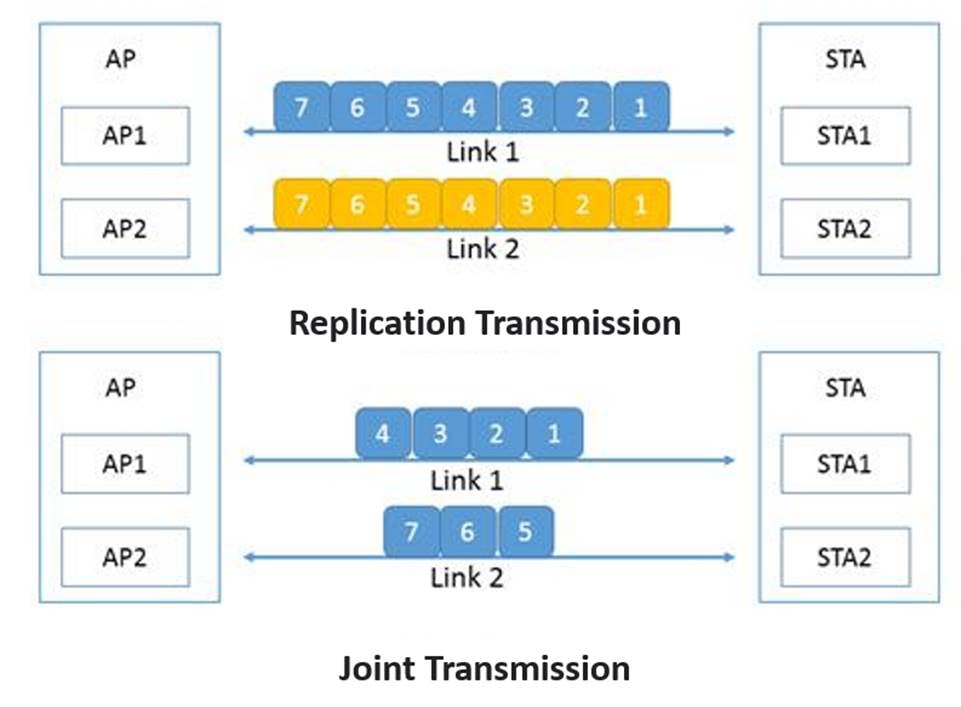
Multi-RU
A subchannel with a specific number of subcarriers is called a RU, and each RU contains at least 26 subcarriers (equivalent to 2MHz bandwidth).
MRU is a technology that improves spectrum resource utilization. In Wi-Fi 6, a single STA can only use a single RU resource allocated to it, and spectrum resource scheduling lacks flexibility. To solve this problem, Wi-Fi 7 allows a single STA to occupy multiple RU resources at the same time, and RUs of different sizes can be combined. Based on the balance between implementation complexity and spectrum resource utilization efficiency, the Wi-Fi 7 protocol also imposes some restrictions on the combination of RUs. Small RUs (<242-Tone) can only be combined with small RUs, and large RUs (≥242-Tone) can only be combined with large RUs. Small RUs cannot be combined with large RUs.
Figure 7 , under the same bandwidth, when transmitting data to two users at the same time, Wi-Fi 7's MRU technology allows a single STA to occupy multiple RU resources at the same time, improving spectrum resource utilization and reducing latency. In Wi-Fi 6, a single STA can only use a single allocated RU resource, resulting in a waste of spectrum resources.
Figure 7: MRU
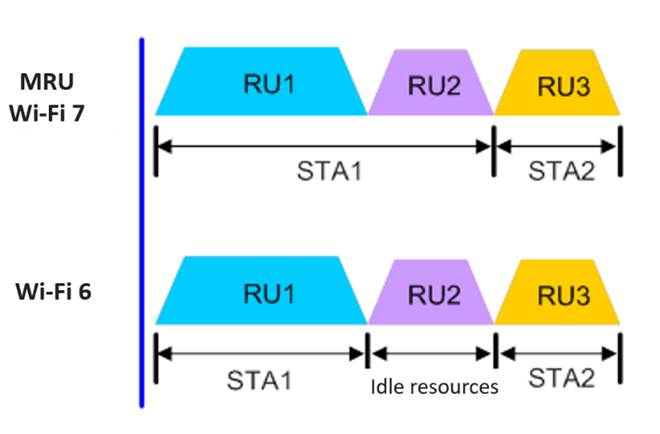
Preamble Puncturing
Preamble Puncturing technology can use discontinuous channels for data transmission and improve channel utilization efficiency. It is mainly used in scenarios with channel interference.
Figure 8 , when transmitting on an 80MHz channel, if interference is encountered on channel 56, the 80MHz bandwidth mode will fall back to 20MHz bandwidth for transmission when the Preamble Puncturing technology is not supported. As shown in Figure 9, after the Preamble Puncturing technology is supported, the interference part (channel 56) on the entire 80MHz channel will be punched and shielded, and then the remaining channels 52, 60, and 64 will continue to be bundled together to transmit information. Although the AP still works in the 80MHz bandwidth mode, in actual transmission, the interfered channel will be placed in the Null state, that is, the idle state.
Figure 8: No Preamble Puncturing (Wi-Fi 6)
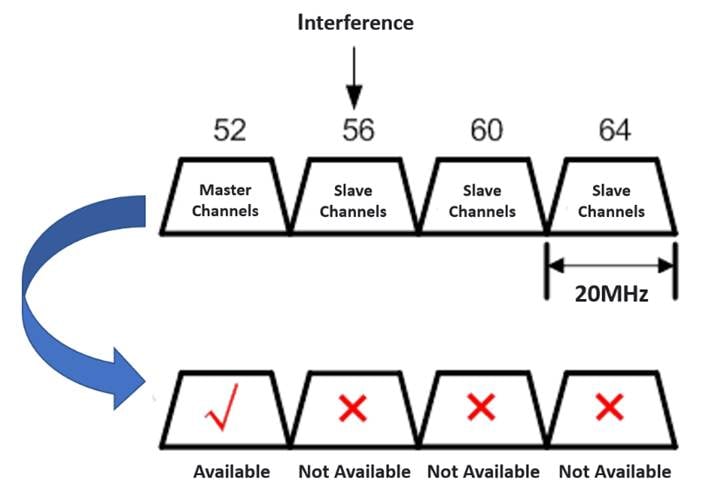
Figure 9: Preamble Puncturing (Wi-Fi 7)
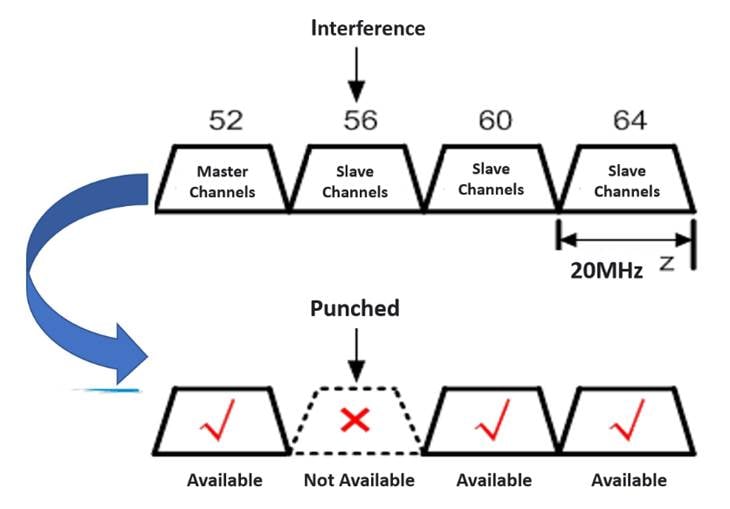
What are the application scenarios of Wi-Fi 7?
The new features of Wi-Fi 7 provide a more superior technical foundation for emerging applications, mainly including the following application scenarios:
- Virtual Reality (VR) and Augmented Reality (AR): Wi-Fi 7’s high speed and low latency make it ideal for supporting VR and AR applications. Users can use Wi-Fi 7 to immerse themselves in VR worlds such as gaming, entertainment, training, and education.
- 8K video transmission: As 8K resolution video devices become more popular, transmitting and streaming 8K videos will require higher bandwidth and more stable connections. Wi-Fi 7's higher speed and higher spectrum utilization efficiency will support high-quality 8K video transmission.
- Wireless health and telemedicine: Wi-Fi 7’s low latency and high reliability make it a key technology for wireless medical devices and telemedicine applications. Medical professionals can monitor and remotely control medical equipment in real time, while providing services such as high-definition video consultations and remote surgery.
- Smart Home: As smart home devices increase, the demand for wireless connectivity is also increasing. Wi-Fi 7's larger network capacity and higher spectrum efficiency will support the connection of more devices, such as smart home appliances, security monitoring, smart lighting and sound systems, etc.
- Autonomous driving and intelligent transportation: Autonomous driving and intelligent transportation systems require high-speed, low-latency wireless connections to enable real-time communication and collaboration between vehicles and between vehicles and infrastructure. The technical advantages of Wi-Fi 7 make it a key supporting technology for these applications.
In summary, the emerging application scenarios of Wi-Fi 7 cover virtual reality, 8K video transmission, wireless medical care, smart home, autonomous driving, and smart transportation. With the continuous advancement and innovation of technology, more new application scenarios will emerge.




